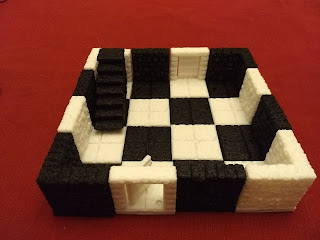Since I've begun working with 3d printed tiles I've noticed that there aren't a lot of resources on setting up your own dungeon using tiles.
My previous builds have all been flat cardboard tiles. There are a lot of things I love about flat cardboard tiles:
Also, it seems like most easily found dungeon maps aren't easily duplicated in dungeon tiles. With either 3d printing or commercial purchase there are several different distinct tile shapes- floors, walls, corners, doors, etc. I wanted to have an idea of how many of each I might need, so I started with looking at the Dwarven Forge Game Tiles Set as a guide. The basic Dwarven Forge set has: 14 walls, 6 corners, 12 floors and 2 doors. Each of these tiles is 2" x 2", which is 10' x 10' in D&D game scale.
Quick disclaimer: the price of my 3d printer was about $175.00 USD delivered. 3d printing PLA filament has been about $30 per reel, but my latest order is only $18. The major cost here is time. I do about 5 tiles a day between morning and evening hours. I could do more but don't want to drive my family crazy with printer noise.This base tile set from Dwarven Forge is only $55. That's pretty affordable and would eliminate all this time spent. But I like to make stuff.
So here's a few pictures of my current pile of tiles. This is all Fat Dragon Games Dragonlock Ultimate Dungeon from the Starter Set. I printed in black and white because I ran out of filament and decided this could be a good way to distinguish between the different tiles at a glance.
The next few Build a Dungeon posts will try to give some basic builds for 3d printed or Dwarven Forge style dungeon tiles!
My previous builds have all been flat cardboard tiles. There are a lot of things I love about flat cardboard tiles:
- No walls get in the way of the player view.
- You can always build vertical surfaces for important elevation.
- No planning space is lost because of tile size.
- They are FAST and easy to make!
Also, it seems like most easily found dungeon maps aren't easily duplicated in dungeon tiles. With either 3d printing or commercial purchase there are several different distinct tile shapes- floors, walls, corners, doors, etc. I wanted to have an idea of how many of each I might need, so I started with looking at the Dwarven Forge Game Tiles Set as a guide. The basic Dwarven Forge set has: 14 walls, 6 corners, 12 floors and 2 doors. Each of these tiles is 2" x 2", which is 10' x 10' in D&D game scale.
Quick disclaimer: the price of my 3d printer was about $175.00 USD delivered. 3d printing PLA filament has been about $30 per reel, but my latest order is only $18. The major cost here is time. I do about 5 tiles a day between morning and evening hours. I could do more but don't want to drive my family crazy with printer noise.This base tile set from Dwarven Forge is only $55. That's pretty affordable and would eliminate all this time spent. But I like to make stuff.
So here's a few pictures of my current pile of tiles. This is all Fat Dragon Games Dragonlock Ultimate Dungeon from the Starter Set. I printed in black and white because I ran out of filament and decided this could be a good way to distinguish between the different tiles at a glance.
The next few Build a Dungeon posts will try to give some basic builds for 3d printed or Dwarven Forge style dungeon tiles!



Comments
Post a Comment